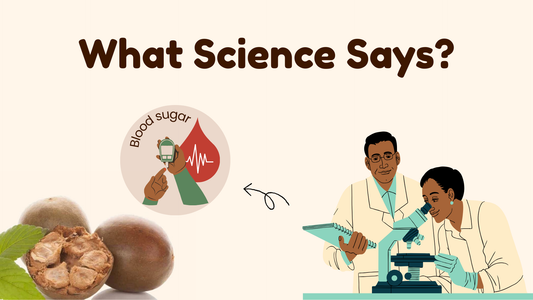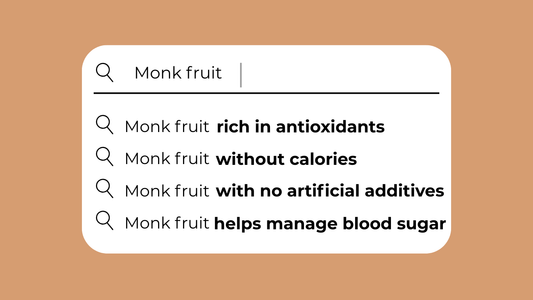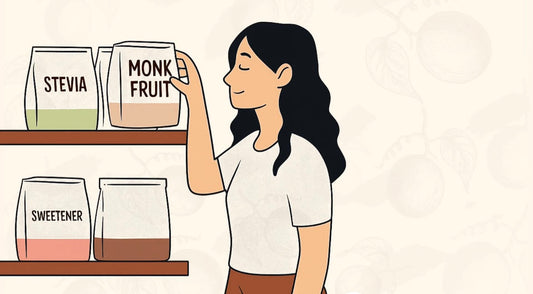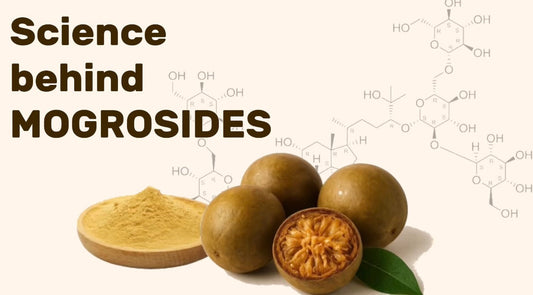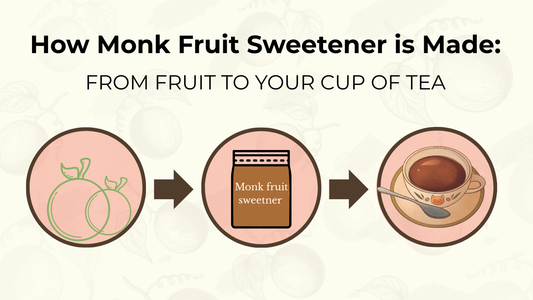Two Natural Sweeteners, One Big Question
When people first hear about monk fruit, the most common reaction is:
“Oh, is it like stevia?”
It’s a fair question. Both monk fruit and stevia are marketed as natural sugar alternatives. Both claim to be better than artificial sweeteners. Both have zero calories. But here’s the thing - they are not the same.
Stevia opened the door, but monk fruit is the upgrade people were waiting for. From taste to science to long-term safety, monk fruit stands apart.
Let’s break it down fully - no half-truths, no hype, just the facts.
The Origins: Fruit vs Leaf
-
Stevia: Comes from the Stevia rebaudiana plant, a leafy shrub native to South America. Indigenous people used the leaves to sweeten teas centuries ago.
-
Monk Fruit: Comes from the Siraitia grosvenorii plant, a round gourd native to Southern China. Buddhist monks cultivated it in the 13th century - hence the name “monk fruit.”
👉 Both are natural, but monk fruit comes from a fruit (with fruit compounds called mogrosides), while stevia comes from a leaf (with compounds called steviol glycosides).
The Compounds Behind Sweetness
-
Stevia’s sweetness: Steviol glycosides (especially rebaudioside A).
-
Monk fruit’s sweetness: Mogrosides (especially mogroside V).
The Difference in How They Work:
-
Steviol glycosides can trigger bitter taste receptors on the tongue, which is why stevia often leaves a metallic or bitter aftertaste.
-
Mogrosides don’t trigger those receptors - monk fruit sweetness is clean and sugar-like, without bitterness.
👉 This is the single biggest reason consumers prefer monk fruit over stevia.
Taste Test: Which One Wins?
-
Stevia: Sweet but often with a bitter, lingering aftertaste. Works fine in some recipes but can overpower in tea, coffee, or light-flavored foods.
-
Monk Fruit: Smooth, clean sweetness. Closer to sugar in taste. Works well across drinks, desserts, and cooking.
👉 For everyday use, monk fruit is the winner. It doesn’t “taste like a diet product.”
Calories and Glycemic Impact
Both monk fruit and stevia are:
-
Zero calorie
-
Zero glycemic index
-
Safe for diabetics
On this front, they tie.
Safety and Side Effects
Stevia
-
FDA-approved and considered safe.
-
Some people report bloating or digestive issues with certain stevia blends (especially when mixed with fillers like maltodextrin).
-
The bitter aftertaste makes many brands “mask” stevia with other additives.
Monk Fruit
-
FDA-approved (GRAS status).
-
No known side effects, even in high amounts.
-
Clean blends (like EPRA’s monk fruit + erythritol) don’t need masking - they taste naturally good.
👉 Monk fruit edges out stevia in tolerability and taste consistency.
Cooking and Baking: Who Performs Better?
-
Stevia: Not heat-stable in all cases. Can develop a licorice-like taste when baked. Works best in cold drinks or light recipes.
-
Monk Fruit: Heat-stable, retains sweetness in baking and cooking. Works in Indian sweets like halwa, ladoos, or payasam - and in cakes, cookies, sauces.
👉 For Indian kitchens where sweets are central, monk fruit fits more naturally.
Research Insights
-
Stevia: Some studies suggest steviol glycosides may help reduce blood pressure and improve insulin sensitivity. However, results are mixed, and long-term taste acceptance is an issue.
-
Monk Fruit: Studies show mogrosides may have antioxidant, anti-inflammatory, and even anti-obesity effects. Unlike stevia, monk fruit has been used in traditional medicine for centuries.
Consumer Acceptance: The Real-World Factor
Globally, stevia has been on the market longer, but consumer feedback often mentions “the aftertaste problem.”
Monk fruit, on the other hand, is rapidly growing because it feels closer to sugar in taste. In markets like the US, food brands are switching from stevia to monk fruit for better consumer acceptance.
Stevia vs Monk Fruit: Side-by-Side
|
Feature |
Stevia |
Monk Fruit |
|
Source |
Leaf (South America) |
Fruit (China/Thailand) |
|
Sweet compounds |
Steviol glycosides |
Mogrosides |
|
Sweetness |
200–300x sweeter than sugar |
100–200x sweeter than sugar |
|
Taste |
Sweet but bitter aftertaste |
Clean, sugar-like sweetness |
|
Heat stability |
Can alter in baking |
Stable in baking/cooking |
|
Side effects |
Possible digestive issues (with fillers) |
No known side effects |
|
Consumer acceptance |
Mixed (aftertaste complaints) |
High (closer to sugar) |
Why EPRA Farms Chose Monk Fruit
At EPRA Farms, we tested different natural sweeteners for India. Stevia had promise, but the bitter aftertaste and limited recipe versatility made it less practical.
Monk fruit stood out because:
-
It tastes better.
-
It performs better in Indian sweets.
-
It’s clean, natural, and safe.
That’s why our products focus on monk fruit + erythritol - the cleanest, most user-friendly alternative to sugar.
Final Takeaway: Monk Fruit vs Stevia
-
Both are natural, zero-calorie sweeteners.
-
Both are safe and diabetic-friendly.
-
But monk fruit wins where it matters: taste, acceptance, versatility.
👉 If stevia was the first generation of natural sweeteners, monk fruit is the upgrade India deserves.
With EPRA Farms, you don’t have to compromise on taste or health. You get both.


